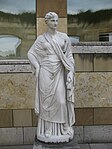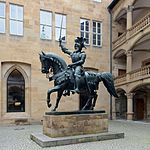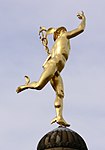Ludwig von Hofer

1854, copies of antique statues by Ludwig Hofer were put up in Stuttgart near the New Palace . The nudity of some of the characters caused moral outrage in large parts of the population.
Johann Ludwig Hofer , von Hofer from 1851 , (born June 20, 1801 in Ludwigsburg , † March 6, 1887 in Stuttgart ) was a German sculptor.
life and work
Ludwig Hofer received his first training in his hometown and in Stuttgart and was called by Leo von Klenze to Munich in 1819 to work on the ornamentation of the Glyptothek .
After working there for four years, he went to Rome , where he stayed for 15 years. In Thorvaldsen's workshop, in which he worked for the first five years, he executed the kneeling angel with the baptismal font that he had designed.
Returning to Stuttgart in 1838, he brought a psyche with him as his own work, which the King of Württemberg bought.
With orders from the latter he repeatedly went to Italy, mainly for the execution of three colossal marble groups, two horse-tamers and the robbery of Hylas for the Stuttgart palace gardens .
Partly on his own initiative, partly on behalf of the king, he began then to replicate a number of the most famous antique and modern statues (including Ceres and Flora , Venus d'Arles ), which almost entirely for the decoration of the Stuttgart palace gardens and the royal country house Schloss Rosenstein used were.
In the latter place there is also an excellent original work by Hofer, an angry cupid. From 1857 to 1859 he created the 4 m high bronze equestrian statue of Duke Eberhard im Bart in the courtyard of the Old Palace in Stuttgart. His work is also the bronze Concordia on the anniversary column of King Wilhelm I in front of the new castle , the golden Mercury on the Mercury column in the old chancellery and the equestrian statue of King Wilhelm I in the forecourt of the Old State Gallery. In 1880 he made a marble group depicting the robbery of Proserpina (Städtisches Lapidarium in Stuttgart). He died in Stuttgart on March 6, 1887 at the age of 85. His grave with a marble bust of Ludwig Hofer by Theodor Bausch (see cover picture) is in Department 8 at the Pragfriedhof in Stuttgart.
Honors
Ludwig von Hofer was awarded the Knight's Cross first class of the Order of the Württemberg Crown in 1850 , which was associated with the personal title of nobility.
Other representation: In an audience with King Wilhelm I (Württemberg) on March 25, 1851, Hofer was officially elevated to the rank of Württemberg court sculptor and ennobled as "von Hofer". In a letter dated March 24, Hofer signed with "L. Hofer", while his correspondence since then with "v. Hofer ”was signed.
In 1884 Hofer was made an honorary citizen of the city of Stuttgart. In 1905 Ludwig-Hofer-Strasse in Stuttgart-Nord was named after him.
Selected Works
Ceres , 1851–1854, Stuttgart, Rotunda of the State Gallery
Flora , around 1855, Stuttgart, Rotunda of the State Gallery
Bronze equestrian statue of Duke Eberhard im Barte , 1857–1859, Stuttgart, inner courtyard of the Old Palace
Gilded statue of Mercury based on Mercury by Giovanni da Bologna in Florence, 1861–1862, Mercury column at the Old Chancellery in Stuttgart
Concordia , 1863, Stuttgart, Schloßplatz
Memorial to Erich and Axel von Taube , who fell together on December 2, 1870 in the Battle of Champigny-Villiers , Carrara marble, 1871–1875, Pleidelsheim , in front of the old town hall
Bronze equestrian statue of King Wilhelm I of Württemberg , 1882–1884, Stuttgart, forecourt of the Alte Staatsgalerie
literature
- Max Bach: Hofer, Johannes Ludwig . In: Allgemeine Deutsche Biographie (ADB). Volume 50, Duncker & Humblot, Leipzig 1905, pp. 383-385.
- Hofer, Johann Ludwig von . In: Hans Vollmer (Hrsg.): General lexicon of fine artists from antiquity to the present . Founded by Ulrich Thieme and Felix Becker . tape 17 : Heubel – Hubard . EA Seemann, Leipzig 1924, p. 240 .
- Patricia Peschel: The Stuttgart court sculptor Johann Ludwig von Hofer (1801–1887) . Hohenheim-Verlag, Stuttgart 2009, ISBN 978-3-89850-984-8 .
Web links
- Works by and about Ludwig von Hofer in the German Digital Library
- Bust of Ludwig Hofer
- Works by Hofer in the Stuttgart Lapidarium
- Missing and wanted - Lapidarium Stuttgart
- Patricia Peschel: Johann Ludwig von Hofer (1801-1887), published on April 19, 2018 in: Stadtarchiv Stuttgart, Stadtlexikon Stuttgart
Individual evidence
- ↑ Royal Württemberg Court and State Manual. 1854, p. 50 ( books.google.de ).
- ↑ Patricia Peschel: The Stuttgart court sculptor Johann Ludwig von Hofer (1801-1887). Work monograph. Stuttgart 2009, p. 23.
| personal data | |
|---|---|
| SURNAME | Hofer, Ludwig von |
| ALTERNATIVE NAMES | Hofer, Johann Ludwig von (full name); Hofer, Ludwig |
| BRIEF DESCRIPTION | German sculptor |
| DATE OF BIRTH | June 20, 1801 |
| PLACE OF BIRTH | Ludwigsburg |
| DATE OF DEATH | March 6, 1887 |
| Place of death | Stuttgart |









